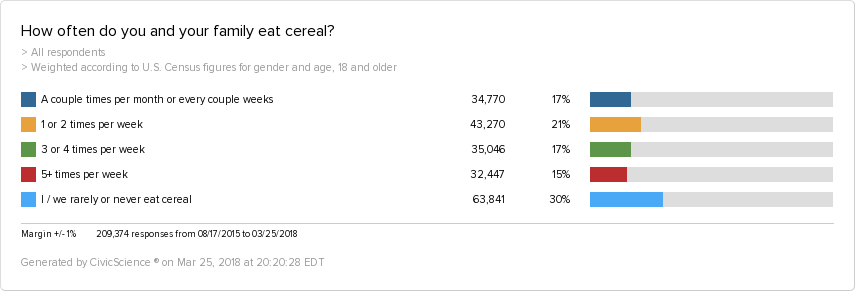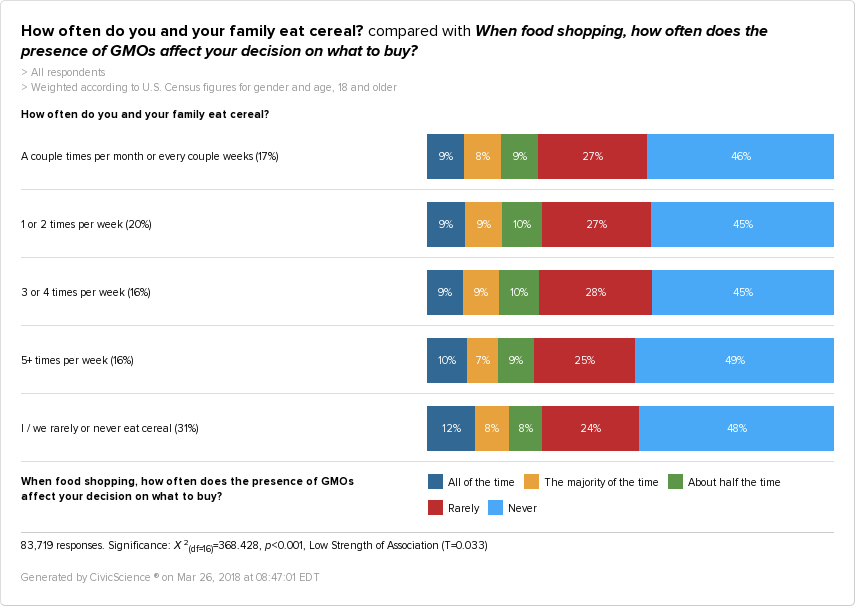The Gist: US Adults who eat cereal generally do so at home. However, regardless of breakfast location, everyone can agree that, when it comes to shopping for cereal, a balance of brand and price is key.
For as long as anyone can remember, breakfast has been touted as “the most important meal of the day.” And for almost just as long, breakfast cereals have held center stage, maintaining a strong showing on the table, besides our beloved orange juice and coffee. With decades of emphasis on this one particular food, we couldn’t help but wonder, what is the status of breakfast cereal in 2018? And what can we learn from cereal consumers about the future of breakfast?
To start, we sought a baseline understanding of how often US Adults are eating cereal.
As the data shows, 30% of US Adults rarely or never eat cereal. However, in the next largest group, 21% eat cereal 1 or 2 times per week. Interestingly, the percentage of US Adults who report eating cereal a couple times per month and those who eat cereal 3 to 4 times per week are equal–both groups make up 17% of responders. So although cereal may not be everyone’s first choice for breakfast, there is still a strong contingent of regular cereal eaters in America.
Of course, just knowing that cereal eaters exist is only the tip of the iceberg. To understand more about this group of consumers, we compared our cereal frequency question to a question on location, asking responders where they typically eat breakfast.
Of the US Adults who report eating cereal anywhere from a couple times a month to 5+ times per week, the overwhelming majority also normally eat at home. This makes sense, as the milk component and spoon necessity can make cereal a challenging ready-to-go option. That said, eating cereal on the road/at work is not uncommon, with 21% of US Adults who eat cereal 1 to 2 times per week choosing this option. The other frequency categories also hover around this 20% mark, indicating that there could be a small but loyal market of consumers looking for fast, portable and convenient breakfast cereal options.
Now that we have a better understanding of the ‘who’ and ‘where’ of cereal consumption, we decided to drill down into consumer purchasing rationale, asking whether brand or price mattered more. The results were clear.
Whether responders eat cereal frequently or rarely, the one thing everyone can agree on is the importance of a balance between brand and price. No other preference came close to the resounding emphasis on both of these factors. The equal focus on brand and price did not waver, even when compared with responders’ annual household income. As income levels rose, the secondary focus switched from price to brand, but the vast majority still believed that both of these factors mattered an equal amount. With a response as unanimous as this, cereal brands should take note.
But what about some of the buzzwords frequently flying around the food world? Genetically Modified Organisms (GMOs) have come under fire in recent years for their potential impact on human health. However, this concern may not have spread as far and wide as we thought.
When we compared our cereal frequency question to a question about the degree to which the presence of GMOs impacts a purchase decision, US Adults seemed to agree that this was almost never a concern. Cereal eaters of all stripes reported that the presence of GMOs never or rarely affected their decision on what do buy.
Another hot topic in food is the designation of organic, so we checked in to see if this was also a concern for US Adults eating and purchasing cereal.
Within the largest group of cereal eaters–those who report eating cereal 1 to 2 times per week–41% reported that they buy organic food occasionally, but not often, while 34% reported never buying it. With the majority of cereal consumers reporting organic food as an occasional or nonexistent priority, it seems the breakfast aisle may not be undergoing major changes any time soon. After all, why fix something that isn’t broken?
In a time when tastes are constantly changing and each week brings a new trend to the food world, cereal somehow transcends these fluctuations. By and large, US Adults who eat cereal are not focused on niche issues such as GMOs or organic ingredients. At the end of the day, or rather, at the beginning of the day, what matters most to cereal connoisseurs is a trusted brand name at an affordable price.













